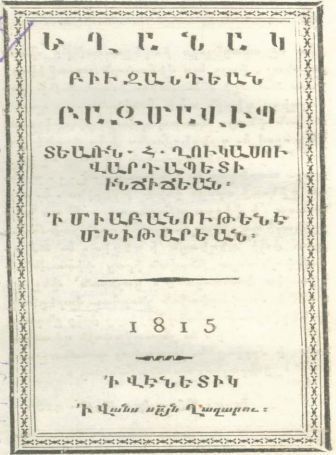Yeghanag Piuzantean Pazmaveb/Troshagk Amenayn Derutiants (Ghougas Injijian, 1815)

Name/Title
Yeghanag Piuzantean Pazmaveb/Troshagk Amenayn Derutiants (Ghougas Injijian, 1815)Secondary Title
Եղանակ Բիւզանդեան Բազմավէպ. Դրօշակք ամենայն տերութեանց.Description
Father Ghougas Injijian was born in 1758 in Constantinople to a family with ties to Adrianople. His father sent him to the Mkhitarist Congregation in Venice in 1770, where his intellect drew the attention of the congregation’s leader. At 16, he became a clergyman and member of the congregation. After periods in Venice and Constantinople, he returned to the latter in 1805 to pursue geographical studies and scholarly work. Injijian spent over two decades in Constantinople, significantly contributing to the Arsharunyats Union, which promoted vernacular Armenian publications. However, his personal library and numerous manuscripts were lost in a fire in 1815. Persecution forced him to flee to Odessa in 1819 and later permanently return to Venice in 1828, where he was elected deputy leader of the congregation. He passed away on July 2, 1833. Ghukas Injijian's Yeghanag Byzantine-Bazmavep yearbook was a groundbreaking publication that combined scientific precision with cultural enrichment, marking a significant moment in Armenian literary history. The yearbook contained detailed astronomical data, such as solar and lunar observations, natural phenomena, and meteorological records, all presented with exceptional accuracy. These observations were paired with additional content aimed at engaging Armenian readers, including parables, poetry, proverbs, historical accounts, and geographical descriptions. Injijian's ability to tailor this content to the intellectual and cultural needs of his audience made the yearbook both unique and accessible. The inspiration for the yearbook came from Giuseppe Toaldo, an Italian astronomer whose Astronomical Almanacs were widely known for their scientific rigor. Injijian adapted Toaldo’s methodology for Constantinople while preserving the core principles of the Italian works. He ensured the yearbook met the spiritual and intellectual demands of Armenians by integrating cultural elements alongside the scientific data. The publication timeline of the yearbook was complex and subject to interruptions. The first volumes were published in 1808 and 1809, but no editions appeared in 1810 or 1811. The yearbook resumed in 1812 with support from the Arsharunyats Society, a literary and cultural organization established in Constantinople and funded by the Duzian brothers. This collaboration allowed Injijian to expand the yearbook’s scope, making it richer and more sophisticated. Further volumes were published in 1813 and annually from 1815 to 1820. These interruptions were caused by Injijian's deteriorating health, financial constraints, and the broader political instability faced by the Mekhitarist Congregation during the early 19th century. The Arsharunyats Society played a vital role in reviving the yearbook and supporting its production. Injijian, as the leading force behind the society, ensured the yearbook addressed both scientific and cultural interests. Despite these efforts, the yearbook faced challenges, including limited public reception and financial instability. In 1819, the Duzian family’s financial downfall led to the dissolution of the society in 1820, effectively ending the yearbook’s publication. The Yeghanag Byzantine-Pazmavep remains a significant achievement in Armenian history. It bridged the gap between European scientific advancements and Armenian cultural preservation. The yearbook introduced modern scientific observations and methodologies to an Armenian audience while maintaining its cultural relevance through the inclusion of educational and literary material. Despite its challenges and eventual cessation, the yearbook serves as a testament to Injijian's resilience and dedication to education and intellectual growth. Its legacy endures as a pioneering work that brought together science and culture, reflecting the intersection of enlightenment and tradition in early 19th-century Armenia. This book also contains an additional book entitled Flags of All Nations which is a significant historical and geographical work that reflects Injijian's dedication to educating Armenian readers about the broader world. This book is one of his noteworthy contributions to Armenian literature and geography, designed to broaden the horizons of its audience by introducing them to the symbols, emblems, and historical and geographical contexts of various nations. The work aligns with Injijian's broader interests in blending education with cultural and historical awareness. It likely included symbolic depictions or explanations of flags, serving as a way to connect Armenians with global knowledge while reinforcing their sense of national identity. This goal was consistent with Injijian's larger mission of making modern concepts of geography, history, and culture accessible to Armenian intellectuals. Flags of All Nations holds historical significance as part of Injijian's legacy of adapting European influences and methodologies for Armenian readers. The book represents his effort to bridge the gap between global knowledge and the Armenian cultural and educational landscape. Although detailed copies or translations of this specific work might be rare, its impact on Armenian scholarship and its role in introducing Armenians to global cultural symbols remain notable.Category
Books

